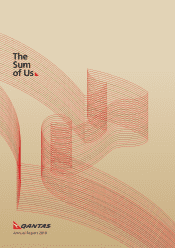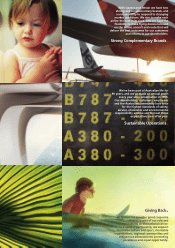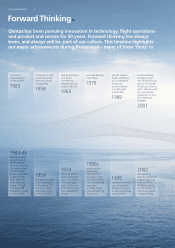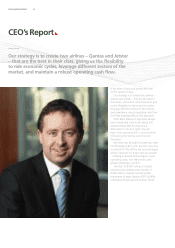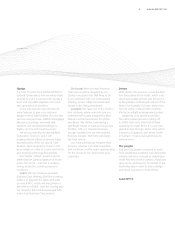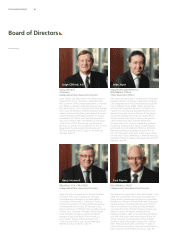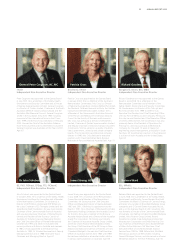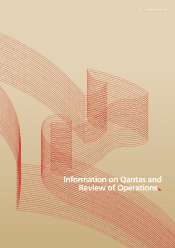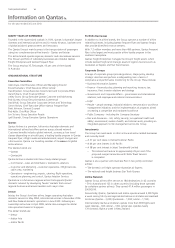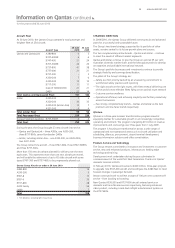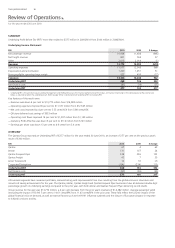Qantas 2010 Annual Report Download - page 8
Download and view the complete annual report
Please find page 8 of the 2010 Qantas annual report below. You can navigate through the pages in the report by either clicking on the pages listed below, or by using the keyword search tool below to find specific information within the annual report.
THE QANTAS GROUP 6
I am pleased to report that the Qantas
Group delivered a good result for
2009/2010 and laid the groundwork
for continuing and sustainable success.
Highlights
Highlights of the year were:
— Underlying Prot Before Tax
of $377 million
— Revenue of $13.8 billion
— Operating cash ow of $1.3 billion
— Cash held at year end of $3.7 billion
In 2008/2009 the Group stood out
in the global aviation sector by recording
a prot, due to its decisive response to
the global nancial crisis. This year the
Group trebled that prot by taking
rapid advantage of improving conditions,
and by maximising the strengths of
Qantas and Jetstar, its two complementary
ying brands.
Key factors
Key factors in the result this year included:
— A robust performance by Qantas, which
was Australia’s most protable and
punctual domestic airline, and which
achieved a signicantly improved
international performance despite
global uncertainty and the impact
of the volcanic ash disruptions
— A record prot by Jetstar, which grew
passenger revenue by 21 per cent
and increased international capacity
by 50 per cent
— A record performance by Qantas
Frequent Flyer, with all-time highs
in customer satisfaction and benets
deriving from enhanced alliance
relationships, notably with the
Woolworths Group
— Industry-leading nancial strength,
including cash holdings of $3.7 billion,
increased operating cash ow, and
the best credit rating of any airline
in the world
— Continuing investment in a modern and
simplied eet, with around 160 aircraft
on order, and an average of one delivery
per month planned for the next
eight years
— Continuing innovation and improvement
in the customer experience, including
the industry-leading Next Generation
Check-in
— Signicant progress towards $1.5 billion
in permanent savings over three years
through the QFuture program, with
$533 million in savings achieved this
year, allied to a business transformation
and simplication agenda
Industry context and outlook
In 2009/2010 global operating conditions
improved from historic lows, with recovery
in demand in both the passenger and
freight markets. International demand
improved across premium and leisure
sectors. Domestic business demand also
returned strongly, although domestic
leisure demand continued to be relatively
soft late in the nancial year.
Looking ahead, the Australian
commercial aviation sector will remain
highly competitive, both domestically
and internationally. Aviation is a complex
industry, subject both to long-term
economic cycles and short-term shocks,
with high xed costs and long investment
lead times. The industry is globalising
unevenly, and still suffers overcapacity
and high start-up and drop-out rates.
To succeed, the Qantas Group’s two
ying brands will be competing vigorously
every day in their different market
segments – the full service Qantas and
the low fares Jetstar.
Reporting clarity
This year the Group introduced a new
primary reporting measure: Underlying
Prot Before Tax (PBT). This is a
non-statutory measure which is now
being used by the Board of Directors
and Executive Committee to assess and
improve the performance of the Group.
Underlying PBT makes it easier for the
Group – and its shareholders – to identify
how well the Group manages those
business factors it controls, by eliminating
the difculty statutory accounting
treatments pose in recording one-off
and high-change factors such as hedge
volatility in currencies and fuel.
Chairman’s Report
This year the Qantas Group trebled last year’s prot
by taking rapid advantage of improving conditions,
and by maximising the strengths of Qantas and Jetstar,
its two complementary ying brands.

